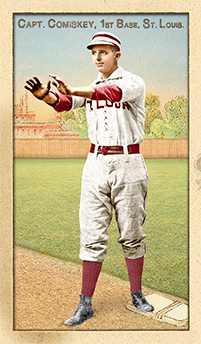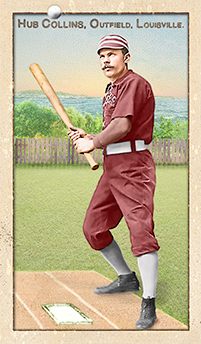
- Series: Beginnings: 1880's
- City: Indianapolis
- Team: Hoosiers (NL)
- League: National League
Lawrence J. Corcoran (1859-1891) was a shining star who left a short trail through the baseball heavens before flaming out in ill-health and an exhausted right arm. He could even use the left one and did pitch ambidextrously on at least one occasion. Few players of any era could have better fulfilled media prophecy: on Sept 13, 1879 the NY Clipper predicted that with good catching support “it would be difficult to get a base hit from his pitching.” Only two others would exceed Larry’s rookie 43 win total. By 1884 Corcoran would hurl his third no-hitter. He was the first to accomplish the feat and it wasn’t matched until Koufax many decades later. For five glorious years with Anson’s White Stockings, Corcoran was phenomenal: 170 wins, 246 CG and the no-nos.
- Unsurprisingly, the arm wearied. His body, afflicted by Bright’s disease, failed too, at age 32
- Per his SABR biographer: “Corcoran possessed all the attributes of greatness except durability”

- Series: Beginnings: 1880's
- City: New York
- Team: Giants
- League: National League
- Hall: National Baseball Hall of Fame
Roger Connor (1857-1931) was the home run king of the 19th century, clouting 138 in his 18-year career. His record stood for 23 years after his retirement, until Babe Ruth surpassed him in 1921. Connor anchored first-base for five teams, winning pennants twice with the Giants. His flair for the dramatic was never more evident than when he struck the first-ever major league grand slam with his team down by three with two outs in the ninth. Born in Connecticut, Roger played for local clubs until joining the Troy Trojans in 1880. That NY hamlet witnessed five future Hall of Famers on their squad with Connor playing alongside Dan Brouthers, Buck Ewing, Tim Keefe and Mickey Welch. After moving to the Gothams, the 6’3” Connor inspired owner Jim Mutrie to proclaim the team “my giants!” and a new identity was born.
- Much more than a slugger, Connor won the NL batting title in 1885 and consistently hit .300+ while exhibiting remarkable speed for a big man (still fifth all-time in triples)
- Connor lived to see Ruth claim his HR title. It was thought at the time, however, that Connor had hit 131 HRS and Ruth's record was celebrated at 132. Writing for SABR in 1975, John tattersall discovered that Connor had actually hit 138 HRs.
- Jay Jaffe's JAWS system ranks Connor as the 5th greatest 1st baseman of all-time, just behind Cap Anson and just ahead of Jeff Bagwell
- Beloved by fans and the baseball press, he had a particularly strong advocate for the Hall in fellow legend, umpire Bill Klem
- Elected to Hall of Fame: 1976

- Series: Beginnings: 1880's
- City: St. Louis
- Team: Browns (AA)
- League: American Association
- Hall: National Baseball Hall of Fame
Charles Albert Comiskey (1859-1931) rose from decent first-baseman to become one of the foremost managers and owners of baseball’s early decades. “The Old Roman’s” leadership skills emerged with his first team, the newly-minted St. Louis Browns whom he piloted to four pennants. He would go on to compile an outstanding 840-541 record. His .608 winning percentage is third-highest behind Joe McCarthy and Jim Mutrie. “Commy” parlayed his ownership of the Western Association’s Dubuque Rabbits into a franchise in the American League which he helped found in 1901. He built the White Sox stadium in 1910 which would bear his name for the next 81 years and presided for the next decade over one of the most talented and troubled teams in history. While many dismiss the charge that it was Comiskey’s penurious ways that “drove” his 1919 squad to infamy, there is no doubt he was a cheapskate of the first order. He underpaid, over-promised and reneged with abandon, epitomizing the arrogance of the reserve-clause era.
- Charles is credited with revolutionizing play at first-base, innovating play off the bag
- Owned the Chicago White Sox from 1901-1931, winning two World Series
- Elected to Hall of Fame: 1939

- Series: Beginnings: 1880's
- City: Louisville
- Team: Colonels
- League: American Association
Hubert B. Collins (1864-1892) was a good-hitting outfielder/second-baseman for two major league clubs from 1886-1892. He came up with the Louisville Colonels of the American Association and moved to the Brooklyn Bridegrooms late in the ‘88 season. Hub played out his career in Brooklyn in both their AA and NL franchises. He managed a fine .284 lifetime average in seven years. In 1890 during his team’s back-to-back title years, Collins led the league in runs scored. The young Louisville native had begun in pro ball with Columbus in the Southern League in ‘85 and came up to his hometown team the next year from Savannah.
- Brooklyn paid the Colonels $4500 for the young utility man in September 1888
- Hub suffered a head injury in a horrific collision with Tom Burns in July 1891. A passing locomotive drowned each others’ call for the short fly ball. He never recovered, succumbing to typhoid fever the next spring
- Hub's uniform color on this card was changed in January, 2017 from blue to maroon to reflect recent reliable research by Craig Brown & friends at Threads of Our Game. Four cards had been previously released featuring a blue uniform.

- Series: Beginnings: 1880's
- City: Philadelphia
- Team: Quakers
- League: National League
John Clements (1864-1941) was known best for being a left-handed catcher and, by far, the most durable and enduring southpaw ever to play the position in the majors. Jack caught four times as many games (1,073) as any other port-sider in history and was the last to catch regularly in the major leagues. Jack played 17 seasons and is credited as the first receiver to wear a chest protector. His .394 BA in 1895 is highest ever at his position and he was among the top four in batting average three times. He was also the first big leaguer to catch 1,000 games. Clements’ power was such that, upon retirement, he was the all-time leader for catchers in single-season and career home runs. Jack came up with the Union Association’s Philadelphia Keystones in that league’s sole season, 1884. When the team folded in August, Jack became the backstop for the National League’s Quakers (Phillies) franchise for 14 seasons before playing out his MLB career with three other teams.
- Jack had trouble laying down the tools. In 1900, following his final year in the NL, he played for the only minor league squad of his long career, a dozen games with the Providence Clamdiggers. He hit .295




